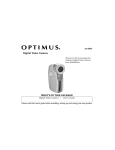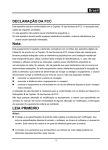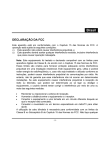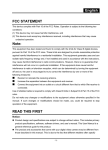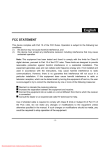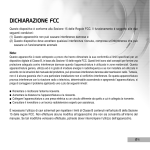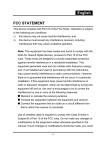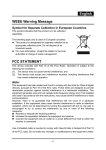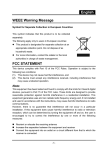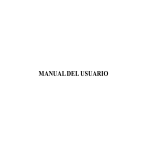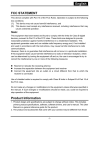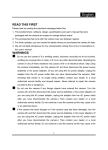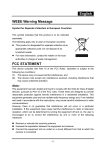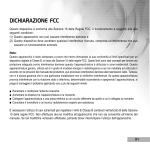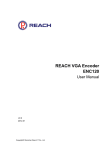Download English WEEE Warning Message FCC STATEMENT
Transcript
English WEEE Warning Message Symbol for Separate Collection in European Countries This symbol indicates that this product is to be collected separately. The following apply only to users in European countries: z This product is designated for separate collection at an appropriate collection point. Do not dispose of as household waste. z For more information, contact the retailer or the local authorities in charge of waste management. FCC STATEMENT This device complies with Part 15 of the FCC Rules. Operation is subject to the following two conditions: (1). This device may not cause harmful interference, and (2). This device must accept any interference received, including interference that may cause undesired operation. Note: This equipment has been tested and found to comply with the limits for Class B digital devices, pursuant to Part 15 of the FCC rules. These limits are designed to provide reasonable protection against harmful interference in a residential installation. This equipment generates uses and can radiate radio frequency energy and, if not installed and used in accordance with the instructions, may cause harmful interference to radio communications. However, there is no guarantee that interference will not occur in a particular installation. If this equipment does cause harmful interference to radio or television reception, which can be determined by turning the equipment off and on, the user is encouraged to try to correct the interference by one or more of the following measures: Reorient or relocate the receiving antenna Increase the separation between the equipment and receiver Connect the equipment into an outlet on a circuit different from that to which the receiver is connected -1- English Use of shielded cable is required to comply with Class B limits in Subpart B of Part 15 of the FCC rules. Do not make any changes or modifications to the equipment unless otherwise specified in the manual. If such changes or modifications should be made, you could be required to stop operation of the equipment. Product Information 1. Product design and specifications are subject to change without notice. This 2. 3. 4. 5. includes primary product specifications, software, software drivers, and user’s manual. This User Manual is a general reference guide for the product. The product and accessories that come with your camera may be different from those described in this manual. This is due to the fact that different retailers often specify slightly different product inclusions and accessories to suit their market requirements, customer demographics, and geographical preferences. Products very often vary between retailers especially with accessories such as batteries, chargers, AC adapters, memory cards, cables, carrying cases/pouches, and language support. Occasionally a retailer will specify a unique product color, appearance, and internal memory capacity. Contact your dealer for precise product definition and included accessories. The illustrations in this manual are for the purpose of explanation and may differ from the actual design of your camera. The manufacturer assumes no liability for any errors or discrepancies in this user manual. For driver updates, you can check the “Download” section of our website, www.geniusnet.com SAFETY INSTRUCTIONS Read and understand all Warnings and Cautions before using this product. Warnings If foreign objects or water have entered the camera, turn the power OFF and remove the battery. Continued use in this state might cause fire or electric shock. Consult the store of purchase. If the camera has fallen or its case has been damaged, turn the power OFF and remove the battery. Continued use in this state might cause fire or electric shock. Consult the store of purchase. Do not disassemble, change or repair the camera. This might cause fire or electric shock. For repair or internal inspection, ask retailer where you purchased it. Do not use the camera in areas near water. This might cause fire or electric shock. Take special care during rain, -2- English snow, on the beach, or near the shore. Do not place the camera on inclined or unstable surfaces. This might cause the camera to fall or tilt over, causing injury. Keep the batteries out of the reach of children. Swallowing batteries might cause poisoning. If the battery is accidentally swallowed, immediately consult a physician. Do not use the camera while you are walking, driving or riding a motorcycle. This might cause you to fall over or result in a traffic accident. Cautions Insert the batteries paying careful attention to the polarity (+ or –) of the terminals. Inserting the batteries with its polarities inverted might cause fire and injury, or damage to the surrounding areas due to the battery rupturing or leaking. Do not fire the flash close to anyone’s eyes. This might cause damage to the person’s eyesight. Do not subject the LCD monitor to impact. This might damage the glass on the screen or cause the internal fluid to leak. If the internal fluid enters your eyes or comes into contact with your body or clothes, rinse with fresh water. If the internal fluid has entered your eyes, consult a physician to receive treatment. A camera is a precision instrument. Do not drop it, strike it or use excessive force when handling the camera. This might cause damage to the camera. Do not use the camera in humid, steamy, smoky, or dusty places. This might cause fire or electric shock. Do not remove the battery immediately after long period of continuous use. The battery becomes hot during use. Touching a hot battery might cause burns. Do not wrap the camera or place it in cloth or blankets. This might cause heat to build up and deform the case, resulting in fire. Use the camera in a well-ventilated place. Do not leave the camera in places where the temperature may rise significantly, such as inside a car. This might adversely affect the case or the parts inside, resulting in fire. Before you move the camera, disconnect cords and cables. Failure to do this might damage cords and cables, resulting in fire and electric shock. -3- English Notes on Battery Usage When you use the battery, carefully read and strictly observe the Safety Instructions and the notes described below: Use only the specified battery (NP60, 3.7V). Avoid using the battery in extremely cold environments as low temperatures can shorten the battery life and reduce camera performance. When you are using the new rechargeable battery or rechargeable battery that has not been used for an extended period of time (the battery that passed the expiry date is an exception) might affect the number of images that can be captured. Therefore, to maximize its performance and lifetime, we recommend that you fully charge the battery and discharge it for at least one complete cycle before use. The battery may feel warm after long period of continuous use of the camera or the flash. This is normal and not a malfunction. The camera may feel warm after long period of continuous use. This is normal and not a malfunction. If the battery is not to be used for a long period of time, remove it from the camera to prevent leakage or corrosion. If the battery is not to be used for a long period of time, store it after no battery power left. If the battery is stored for a long time in a fully charged state, its performance may be impaired. Always keep the battery terminals in a clean state. Risk of explosion if battery is replaced by an incorrect type. Dispose of used batteries according to the instructions. We recommend the battery should be charged 8 hours for first time use. -4- English CONTENTS INTRODUCTION ____________________________________________________ 8 OVERVIEW _________________________________________________________ 8 PACKAGE CONTENTS _________________________________________________ 8 GETTING TO KNOW YOUR DIGITAL VIDEO CAMERA _____________________ 9 FRONT VIEW _______________________________________________________ 9 REAR VIEW _______________________________________________________ 10 LCD MONITOR INFORMATION __________________________________________ 11 Video Mode _____________________________________________________ 11 Capture Mode ___________________________________________________ 12 Video Playback __________________________________________________ 13 Still Image Playback ______________________________________________ 13 Audio/MP3 Playback______________________________________________ 13 GETTING STARTED ________________________________________________ 14 INSERTING THE BATTERY _____________________________________________ TURNING THE POWER ON/OFF _________________________________________ LCD INDICATOR ____________________________________________________ ATTACH THE STRAP _________________________________________________ INSERTING THE SD MEMORY CARD ______________________________________ USING THE LCD PANEL _______________________________________________ SETTING THE DATE AND TIME __________________________________________ CHOOSING THE DISPLAY LANGUAGE _____________________________________ FORMATTING INTERNAL MEMORY OR AN SD MEMORY CARD____________________ SETTING IMAGE RESOLUTION AND QUALITY ________________________________ POSSIBLE NUMBER OF SHOTS (STILL IMAGE) _______________________________ POSSIBLE RECORDING TIME / SEC (VIDEO CLIP) _____________________________ 14 14 14 15 15 16 16 17 17 18 19 19 PHOTOGRAPHY MODE _____________________________________________ 20 CAPTURING STILL IMAGES ____________________________________________ RECORDING VIDEO CLIPS _____________________________________________ NORMAL MODE ____________________________________________________ MARCO MODE _____________________________________________________ USING THE DIGITAL ZOOM_____________________________________________ SETTING THE FLASH _________________________________________________ SETTING THE SELF-TIMER _____________________________________________ TV RECORDING MODE _______________________________________________ 20 20 20 21 21 22 23 23 PLAYBACK MODE _________________________________________________ 24 PLAYING BACK STILL IMAGES / VIDEO CLIPS _______________________________ 24 PLAYING BACK STILL IMAGES/VIDEO CLIPS ON TV ___________________________ 24 -5- English ZOOM PLAYBACK ___________________________________________________ THUMBNAIL DISPLAY _________________________________________________ PROTECTING IMAGES ________________________________________________ SLIDE SHOW DISPLAY________________________________________________ DELETE STILL IMAGE / VIDEO CLIPS _____________________________________ 25 25 26 26 27 MP3 MODE________________________________________________________ 28 AUDIO RECORDING MODE __________________________________________ 29 RECORDING AUDIO FILES _____________________________________________ 29 PLAYING BACK AUDIO FILES ___________________________________________ 29 DELETING MP3 / AUDIO FILES _________________________________________ 30 MENU OPTIONS ___________________________________________________ 31 VIDEO MENU ______________________________________________________ Size ___________________________________________________________ Quality _________________________________________________________ EV ____________________________________________________________ AWB __________________________________________________________ CAPTURE MENU ____________________________________________________ SIZE __________________________________________________________ QUALITY_______________________________________________________ EV ____________________________________________________________ AWB __________________________________________________________ ISO ___________________________________________________________ DATE PRINT____________________________________________________ TV MENU ________________________________________________________ SIZE __________________________________________________________ QUALITY_______________________________________________________ PLAYBACK MENU ___________________________________________________ Slide Show _____________________________________________________ DELETE FILE ___________________________________________________ DELETE ALL____________________________________________________ PROTECT______________________________________________________ MP3 / AUDIO MENU _________________________________________________ PLAY MODE ____________________________________________________ REPEAT _______________________________________________________ DELETE _______________________________________________________ SYSTEM MENU _____________________________________________________ LANGUAGE ____________________________________________________ FORMAT _______________________________________________________ LCD BRIGHT ___________________________________________________ DATE TYPE ____________________________________________________ DATE SETUP ___________________________________________________ POWER OFF ___________________________________________________ -6- 31 31 31 31 31 32 32 32 32 32 33 33 33 33 33 34 34 34 34 34 34 35 35 35 35 35 35 36 36 36 36 English COPY TO CARD_________________________________________________ VIDEO OUT ____________________________________________________ RESET ________________________________________________________ LIGHT FREQ. ___________________________________________________ BEEP__________________________________________________________ 36 36 36 36 36 CONNECTING TO A PICTBRIDGE COMPLIANT PRINTER _________________ 37 TRANSFERRING RECORDED IMAGES AND VIDEOS TO YOUR COMPUTER _ 39 STEP 1: INSTALL THE USB DRIVER (WINDOWS 98 ONLY) ______________________ 39 STEP 2: CONNECTING THE DIGITAL VIDEO CAMERA TO YOUR COMPUTER __________ 39 STEP 3: DOWNLOADING STILL IMAGES, VIDEO CLIPS AND AUDIO FILES _____________ 40 USING THE DIGITAL VIDEO CAMERA AS A WEB CAMERA _______________ 41 STEP 1: INSTALL THE WEB CAMERA DRIVER _______________________________ 41 STEP 2: CONNECT THE DIGITAL VIDEO CAMERA TO YOUR COMPUTER _____________ 42 STEP 3: RUN YOUR APPLICATION SOFTWARE ______________________________ 42 INSTALLING VIDEOSTUDIO__________________________________________ 43 SPECIFICATIONS __________________________________________________ 44 TROUBLESHOOTING _______________________________________________ 45 -7- English INTRODUCTION Overview Thank you for purchasing this new digital video camera! This digital video camera is designed as an “entry-level” handy cam. Equipped with a 5.0 mega pixel CMOS sensor, your camera delivers good quality, 3264 x 2448 resolution images. Other features provided by the digital video camera include the following: True 5.0 mega pixel CMOS sensor Maximum 8.0 mega pixel resolution in still image 2.5” Color LTPS TFT LCD 8X digital zoom 7-in-1 Functions: Digital Video Camera, Digital Still Camera, TV Recording and playback, MP3 Player, Voice Recording, Web Camera and Mass storage device. Powerful MPEG4 video format for larger image capacity and better quality. Supports 12 types of photo frames in camera mode. PictBridge support Package Contents Carefully unpack your kit box and ensure that you have the following items. In the event that any item is missing or if you find any mismatch or damage, promptly contact your dealer. Common Product Components: 1. Digital Video Camera 2. CD driver includes: Ulead VideoStudio SE 8.0 USB/Web Cam driver for Windows 98SE/2000/ME/XP Multi-Language User’s Manual 3. USB cable 4. AV cable 5. AC power adapter 6. Battery charger 7. AC Plug Adaptor for EU to US 8. One NP-60 Lithium ion rechargeable Battery 9. Quick Guide 10. Pouch 11. Strap -8- English GETTING TO KNOW YOUR DIGITAL VIDEO CAMERA Front View 6 5 4 1 2 3 7 8 1. Lens 2. Flash 3. Self-timer LED 4. Focus switch Normal mode Macro mode 5. Speaker 6. Microphone 7. Battery/SD memory card cover 8. Tripod socket -9- English Rear View 15 1 2 3 9 4 6 10 11 7 8 12 13 14 Power button 1. 2. MODE Mode button 3. Zoom lever T Zoom in W Zoom out Record button 4. 5. Image button Right button 6. Self-timer button Left button Flash button 8. MENU Menu button 9. Status LED indicator 10. USB connector 11. A/V IN terminal 12. A/V OUT terminal Earphone connector 13. 14. Strap holder 15. LCD panel / monitor 7. -10- 5 English LCD Monitor Information Video Mode 10 9 8 7 6 1 2 5 3 4 1. Video mode icon 2. Zoom status 3. Battery power indicator Full battery power Medium battery power Low battery power Virtually no battery power 4. SD memory card indicator An SD memory card is loaded No SD memory card is loaded SD memory card is full 5. Macro mode 6. EV compensation 7. White balance AUTO AUTO DAYLIGHT LAMP FLUORESCENT-1 FLUORESCENT-2 SHADE 8. Video quality SUPER FINE FINE NORMAL 9. Video resolution 640 x 480 pixels 320 x 240 pixels 10. Available recording time (Before recording)/Elapsed time (While recording) -11- English Capture Mode 13 12 11 10 9 8 1 2 7 3 5 6 1. Still image mode icon 2. Zoom status 3. Battery power indicator 4. SD memory card indicator 5. Available number of shots 6. Flash mode Flash off Auto flash Auto flash with red-eye reduction 7. Macro mode 8. ISO sensitivity AUTO ISO 100 ISO 200 ISO 400 4 9. EV compensation 10. AWB (White balance) 11. Image quality SUPER FINE FINE NORMAL 12. Image resolution 3264 x 2448 (FW interpolation) 2560 x 1920 2048 x 1536 1.2M 1280 x 960 640 x 480 13. Self-timer indicator (if used) 3-seconds delay 10-seconds delay -12- English Video Playback 1. Folder and file name 2. Duration of current video (Before playback)/ Elapsed time (During playback) Video playback mode icon 3. 4. Battery power indicator 5. SD memory card indicator 6. Playback indicator 7. Video status bar 8. Sound level (speaker volume) Low volume Mild volume Medium volume High volume Fully volume Mute (no sound) 4 Still Image Playback 1 1. Still-image playback mode 2. Battery power indicator 3. SD memory card indicator 4. Folder and file name 2 Audio/MP3 Playback 7 1. / Audio/MP3 playback mode icon 2. File name 3. Battery power indicator 4. SD memory card indicator 5. Audio/MP3 status bar 6. Sound level (speaker volume) 7. Playback indicator 8. Play mode indicator Play one file Play all files Play the selected files Repeat indicator 9. 10. Elapsed time 8 9 10 00:00:32 1 AUD_0001 2 3 6 -13- 5 4 English GETTING STARTED Inserting the Battery We highly recommend using the specified rechargeable lithium-ion battery to realize the fully capability of your digital video camera. Charge the battery before using the digital video camera. Make sure that the power of the digital video camera is off before inserting or removing the battery. 1. Slide the battery/SD memory card cover. 2. Insert the battery in the correct orientation, as shown. 3. Close the battery/SD memory card cover firmly. . Turning the power On/Off Press and hold the button until the digital video camera turns on. To turn the power off, press and hold the button again. LCD Indicator Indicator LED indicator Status Solid green LED indicator Blinking green Blinking red Blinking red LED indicator Self timer indicator Description/Activity 1. The digital video camera is powering up. 2. The digital video camera is ready to record images (or video clips). USB communication/transfer is in progress. Charging the flash. The self-timer function is activated. -14- English Attach the strap Attach the strap as shown in the illustration. Inserting the SD Memory Card The digital video camera comes with 32MB of internal memory (24MB available for image storage); allowing you to record video clips, capture still images, MP3 and audio files in the digital video camera. However, you can also expand the memory capacity by using an SD memory card so that you can store more files. 1. Open the battery/SD memory card cover. 2. Insert the SD memory card. If the card cannot be inserted, check the orientation. 3. Close the battery/SD memory card firmly. To remove the SD memory card, make sure the camera is turned off. Open the battery/SD memory card cover, then press lightly on the edge of the memory card and it will eject. NOTE • • • Be sure to format an SD memory card with this digital video camera before using it. Refer to section in the manual titled “Formatting an SD memory card” for further details. To prevent valuable data from being accidentally erased from an SD memory card, you can slide the write protect tab (on the side of the SD memory card) to “LOCK”. To save, edit, or erase data on an SD memory card, you must unlock the card. -15- English Using the LCD panel 1. 2. Open the panel by pulling it away from the digital video camera. Choose the angle of the monitor that suits you best by rotating the panel. NOTE z Make sure you open the LCD panel at 90 degrees before attempting to rotate it. z Rotate the LCD panel carefully and in the correct direction, over rotation and rotation in the wrong direction may damage the hinge that connects the LCD monitor to the digital video camera. z Avoid contact with the LCD monitor when moving the LCD panel. z Do not hold the digital video camera by the LCD panel. Setting the Date and Time The date/time setting screen will automatically appear: When first turning the digital video camera on; When turning the power on after leaving the digital video camera without the batteries for an extended period of time. 1. Turn on your digital video camera. 2. Press the MENU button. button. 3. Move to [SYSTEM MENU] by using the button. 4. Select [DATE SETUP] with the zoom lever, and press the The [DATE SETUP] setting screen is displayed. / buttons and adjust the vale for the date 5. Select the item’s field with the and time with the zoom lever. button. 6. After confirming all settings are correct, press the -16- English Choosing the Display language Choose a language for information displayed on the LCD monitor. 1. Turn on your digital video camera. 2. Press the MENU button. button. 3. Move to [SYSTEM MENU] by using the 4. Select [LANGUAGE] with the zoom lever, and button. press the The [LANGUAGE] setting screen is displayed. 5. Select the desired language using the zoom lever, and press the confirm the selection. button to Formatting Internal Memory or an SD Memory Card Formatting erases all images, videos, sound, MP3 files and folders that are stored on the SD memory card or in internal memory. Formatting is not possible if an SD FORMAT memory card is locked. 1. Turn on your digital video camera. 2. Press the MENU button. button. 3. Move to [SYSTEM MENU] by using the button. 4. Select [FORMAT] with the zoom lever, and press the button. 5. Select [YES] with the zoom lever, and press the 2005/08/24 NOTE • • • • You should format an SD memory card before using it for the first time. Formatting an SD memory card also erases the protected images. All data other formatting the card, make sure that all the images are unnecessary. Formatting is an irreversible action and data cannot be recovered at a later time. An SD memory card having any problem cannot be properly formatted. -17- English Setting Image Resolution and Quality Resolution and quality settings determine the pixel size (dimension), image file size, and compression ratio for your images. These settings affect the number of images that can be stored. As you get to know the camera, it is recommended that you try each quality and resolution setting to get an appreciation for the effects that these settings will have on your images. Higher resolution and higher quality images offer the best photographic results, but produce large file sizes. Therefore, a few images will take up a lot of memory space. High resolution and quality settings are recommended for printed output and situations requiring the finest detail. Lower resolution/quality images take up less memory space and may be quite suitable for sharing images via e-mail, in a report, or on a web page. To change image resolution or image quality, perform these steps below: 1. Turn on your digital video camera. 2. Press the MODE button continuously until the Capture or Video Mode appears. 3. Press the MENU button. The [CAPTURE MENU] or [MOVIE MENU] screen is displayed. 4. Select [SIZE] with the zoom lever, and press button to view the resolution choices. the 5. Select the desired resolution with the zoom lever, and press the button to confirm. CAPTURE MENU 6. Select [QUALITY] with the zoom lever, and button to view the quality press the choices. 7. Select the desired quality with the zoom lever, button to confirm. and press the NOTE • The possible number of shots and recording time depend on the storage size, resolution and quality settings and the subject of the image to be captured. -18- English Possible number of shots (still image) This table shows approximate shots that you can capture at each setting based on the internal memory or an SD memory card. SD memory Card capacity Size Quality Internal Memory 64MB 128MB 256MB 512MB 1GB 3264 x 2448 2560 x 1920 2048 x 1536 1280 x 960 640 x 480 SUPER FINE FINE NORMAL SUPER FINE FINE NORMAL SUPER FINE FINE 4 9 14 7 15 23 11 23 12 24 36 19 39 59 30 60 24 49 73 40 79 120 62 123 49 97 146 79 158 239 124 247 95 189 284 154 308 464 241 479 190 380 570 309 616 929 483 959 NORMAL SUPER FINE FINE NORMAL SUPER FINE FINE NORMAL 35 30 59 88 115 214 249 91 78 153 226 295 480 640 185 159 312 458 600 975 1300 370 317 622 916 1197 1946 2595 718 616 1207 1776 2322 3774 5032 1438 1233 2417 3554 4648 7553 10070 Possible recording time / sec (video clip) Size 640 x 480 320 x 240 • Quality Internal Memory SD memory Card capacity 128MB 256MB 512MB 64MB SUPER FINE 00:43 01:53 03:53 07:47 15:08 30:20 FINE 00:57 02:31 05:10 10:21 20:07 40:19 NORMAL 01:11 03:08 06:26 12:54 25:04 50:14 SUPER FINE 01:08 03:01 06:11 12:24 24:05 48:15 FINE 01:42 04:29 09:12 18:27 35:50 1:11:48 NORMAL 02:15 05:56 12:10 24:24 47:24 1:34:59 1GB The data shows the standard testing results. The actual capacity varies according to the shooting conditions and settings. -19- English PHOTOGRAPHY MODE Capturing Still Images In this mode, you may capture still images. 1. Turn on your digital video camera. 2. Press the MODE button continuously until the Capture Mode appears. 3. Compose your image on the LCD monitor. button to capture a still image. 4. Press the The actual captured image appears to be larger than the one on the LCD preview after image captured. Recording Video Clips In this mode, you may record video clips. 1. Turn on your digital video camera. 2. The default mode is Video Mode. If not, press the MODE button continuously until the Video Mode appears. 3. Compose the shot. button. 4. Press the The recording of the video clip will start. Pressing the button again will pause the button during recording. Pressing the pause will resume recording. button to stop recording. 5. Press the NOTE • When recording video clips, the flash and self-timer cannot be used. Normal Mode This mode is suitable for scenery and portrait shooting. 1. Turn on your digital video camera. side. 2. Slide the focus switch to the 3. Compose the shot. button to capture a still image. 4. Press the To record video clips, press the button to button to start recording, and then press the end the recording. -20- English Marco Mode Select this when you want to take a close-up photo. 1. Turn on your digital video camera. 2. Slide the focus switch to the side. 3. Compose the shot. button to capture a still image. 4. Press the To record video clips, press the button to start recording, and then press the button to end the recording. NOTE • • After a macro shot is taken DO NOT FORGET to reset the lens to the normal position. Flash mode is automatically set to off once you switch to Macro mode. Using the Digital Zoom Zoom photography allows you to capture telephoto and wide-angle shots. 1. Turn on your digital video camera. 2. Compose the shot with the zoom lever. The subject appears closer by sliding the zoom lever to the T side. The subject appears farther away by sliding the zoom lever to the W side. button to capture a “zoomed” 3. Press the image. To record video clips, press the button button to end the recording. to start recording, and hen press the You can also use the zoom lever to zoom in or zoom out the subject while recording the video clips. NOTE • The digital zoom range is from 1x to 8x. -21- English Setting the Flash Set the flash to suit the photographic conditions. 1. Turn on your digital video camera. button to select the desired flash mode. 2. Press the The table below will help you choose the appropriate flash mode: Flash mode Description [ ] Flash Off The flash will not fire. Select this mode when capturing images in a place where flash photography is prohibited, or when the distance to the subject is beyond the effective range of the flash. The flash fires automatically according to the ambient Auto Flash lighting conditions. Select this mode for general flash photography. [ ] Auto Flash with Use this mode to reduce the red-eye phenomenon Red-eye Reduction when you want to capture natural-looking images of people and animals in low-light conditions. When capturing images, the red-eye phenomenon can be reduced by asking the subject (person) to look at the digital video camera or get as close to the digital video camera as possible. NOTE • The flash cannot be set in video mode. -22- English Setting the Self-timer This setting allows still images to be captured with the self-timer. 1. Turn on your digital video camera. 2. Press the button to select the setting. 3. Compose the shot. button. 4. Press the The self-timer LED and self-timer icon flash, and then the image is captured after the preset time has elapsed. To cancel the self-timer during operation, press again the button. Once the self-timer has been activated and the button has been pressed, you can not slide the zoom lever. The table below will help you choose the appropriate self-timer mode: Self-timer mode Description 3 sec. The picture is taken about 3 seconds after the button is pressed. 10ec. The picture is taken about 10 seconds after the button is pressed. NOTE z Self-timer cannot be set in video mode. z The self-timer setting is automatically cancelled after an image is captured. TV Recording Mode The TV recording function allows you to record a TV program from a television. 1. Connect one end of the A/V IN cable to the A/V IN terminal of the digital video camera. TV 2. Connect the other end to the A/V output socket of the TV set. 3. Turn the TV and device on. 4. Toggle the MODE button to select the TV mode. button to start recording. To stop recording, press the 5. Press the button. NOTE • • The AV cable must be connected to the device and TV set, otherwise, the TV recording function will not be available to use. Switching the TV channel during the TV program recording process may cause the device to stop or hang up. -23- English PLAYBACK MODE Playing Back Still Images / Video Clips You can playback the still images on an LCD monitor. 1. Turn on your digital video camera. 2. Toggle the MODE button to go to [SELECT MODE]. 3. Select [IMAGE/MOVIE] with the zoom lever and button. press the The last image/video clip appears on the LCD monitor. 4. Select the desired images with the zoom lever. To view the previous image, slide the zoom lever to the T side. To view the next image, slide the zoom lever to the W side. To start playing back the video clips, follow the steps 1-4 above, then press the button. A press of the / buttons during playback allows fast forward play / button; to cancel fast reverse play. To pause video playback, press the button again. pause, press the To stop video playback, press the button. This stops playback and returns to the start of the video clip. NOTE • • If the video cannot playback in WMP 9.0, please update WMP 9.0 from the Microsoft website. To adjust the sound level, sliding the zoom lever to the T side will increase the volume, sliding the zoom lever to the W side will decrease the volume. Playing Back Still Images/Video Clips on TV You can also playback your images on a TV screen. Before connecting to any devices, make sure to select NTSC / PAL system to match the video output system of the video equipment you are going to connect to the digital video camera, then turn all connected devices off. 1. Connect one end of the A/V OUT cable to the A/V OUT terminal of the digital video camera. -24- TV English 2. 3. 4. Connect the other end to the A/V input socket of the TV set. Turn the TV and digital video camera on. Playback the still images / video clips. The method of operation is the same as playing back still images and video clips on the digital video camera. Zoom Playback Images that are being played back can be enlarged. The zoom factor displayed on the screen shows the current magnification ratio. 1. Turn on your digital video camera. 2. Toggle the MODE button to go to [SELECT MODE]. 3. Select [IMAGE/MOVIE] with the zoom lever and press the button. 4. Select the desired image with the zoom lever. 5. The displayed image can be enlarged by each press of the button. The magnification factors range from 1x to 8x (within 16 stages: 1.0x, 1.5x, 2.0x, 2.5x, 3.0x, 3.5x, 4.0x, 4.5x, 5.0x, 5.5x, 6. 0x, 6.5x, 7.0x, 7.5x, 8.0x and thumbnail display). During zoom playback, the outer frame indicates the entire image; while the inner frame indicates the location of the currently enlarged area. 6. Slide the zoom lever upward or downward or press the / buttons to select the area to enlarge. Thumbnail Display This function allows you to view 9 thumbnail images on the LCD monitor at the same time, so you can quickly search for the image that you want. 1. Follow "Zoom Playback" section steps 1-5 until the thumbnail display is on the screen. / buttons or the zoom lever to 2. Press the select the image/video clip to be displayed at regular size. button. 3. Press the -25- 101-0001 001 / 0010 English Protecting Images Set the data to read-only to prevent images from being erased by mistake. PLAYBACK MENU 1. Turn on your digital video camera. SLIDE SHOW 5 SEC ONE FILE DELETE FILE 2. Toggle the MODE button to go to [SELECT DELETE ALL ALL FILE MODE]. PROTECT EXIT 3. Select [IMAGE/MOVIE] with the zoom lever and button. press the 4. Select the still image/video clip that you want to protect with the zoom lever. You may select the still image/ video clip ONE FILE that you want to protect from the thumbnail display. LOCK UNLOCK 5. Press the MENU button. The [PLAYBACK MENU] is displayed. 6. Select [PROTECT] with the zoom lever, and 100-0002 button. press the 7. Select [ONE FILE] or [ALL FILE] with the zoom lever, and press the button. / buttons, 8. Select [LOCK] by pressing the and press the button. Protect is executed and the digital video camera returns to the play mode. The protect icon is displayed with protected images. When [ALL FILE] is displayed with all the images. is selected, To cancel protection, follow the step 5-8 to select [UNLOCK] by pressing / buttons, and press the button. the The removal of image protection is executed and the digital video camera returns to the play mode. Slide Show Display The slideshow function enables you to playback still images/video clips automatically in order one image at a time. 1. Turn on your digital video camera. 2. Toggle the MODE button to go to [SELECT MODE]. 3. Select [IMAGE/MOVIE] with the zoom lever and button. press the 4. Press the MENU button. -26- PLAYBACK MENU SLIDE SHOW 5 SEC. DELETE FILE 7 SEC. DELETE ALL 9 SEC. PROTECT ONE FILE English 5. 6. Select [SLIDE SHOW] with the zoom lever, and press the button. Set the playback interval with the zoom lever, and press the button. The slide show starts. The video clips are displayed the first frame image, and not played back. To stop slide show, press the button. NOTE • You can adjust slide show display interval within the range of 5 SEC, 7 SEC, and 9 SEC. Delete Still Image / Video Clips 1. 2. Turn on your digital video camera. Toggle the MODE button to go to [SELECT PLAYBACK MENU SLIDE SHOW 5 SEC. MODE]. DELETE FILE YES 3. Select [IMAGE/MOVIE] with the zoom lever and NO DELETE ALL button. press the ONE FILE PROTECT 4. Select the still image/video clip that you want to erase with the zoom lever. You may select the still image/ video clip PLAYBACK MENU that you want to erase from the thumbnail SLIDE SHOW 5 SEC. display. ONE FILE DELETE FILE 5. Press the MENU button. YES DELETE ALL 6. Select [DELETE FILE] or [DELETE ALL] with the NO PROTECT button. zoom lever, and press the [DELETE FILE]: Delete the current still image/video clip. [DELETE ALL]: Delete all still images/video clips. button. 7. Select [YES] with the zoom lever, and press the To not delete, select [NO], and press the button. If all video clips/images are deleted, [NO FILE!] pops up. If you want to turn back to the photography mode, press the MODE button. -27- English MP3 Mode The digital video camera lets you playback MP3 files. You may download MP3 files to your computer and then copy them into the digital video camera via the USB cable or insert an SD memory card with MP3 files recorded into the digital video camera. 1. Turn on your digital video camera. 2. Toggle the MODE button to go to [SELECT MODE]. 3. Select [MP3] with the zoom lever and press the button. The MP3 LIST appears on the screen. SELECT MODE IMAGE / MOVIE MP3 AUDIO MP3 LIST SUMMER LOVE WITHOUT YOU MR. RIGHT PAGE 1 2 :add Button operations State Button Playlist Power off (press & hold) T Scroll up W Scroll down Previous page Next page/Add selection MODE Back to LCD preview MENU Enter MP3 menu Start to play MP3 music -28- MP3 During playback Power off (press & hold) Volume + Volume Stop playing MP3 music Pause playing MP3 music :play English AUDIO RECORDING MODE The digital video camera enables you to record and playback audio files anytime and anywhere. Recording Audio Files 1. 2. 3. Turn on your digital video camera. Toggle the MODE button to select audio recording mode as the illustration. button. Press the Voice starts recording. To pause recording, press the button again. To stop recording, press the button. The maximum recordable time for voice recording is over 1 hour. SELECT MODE IMAGE / MOVIE MP3 AUDIO Playing Back Audio Files 1. 2. 3. Turn on your digital video camera. Toggle the MODE button to go to [SELECT MODE]. Select [AUDIO] with the zoom lever and press the button. The AUDIO LIST appears on the screen. Button operations State Button Playlist Power off (press & hold) T Scroll up W Scroll down Previous page Next page/Add selection MODE Back to LCD preview MENU Enter AUDIO menu Start to play voice file -29- AUDIO LIST AUD_0001 AUD_0002 AUD_0003 AUD_0004 PAGE 1 2 :add Audio During playback Power off (press & hold) Volume + Volume Stop playing Audio file Pause playing Audio file :play English Deleting MP3 / Audio Files 1. 2. 3. 4. 5. 6. Turn on your digital video camera. Toggle the MODE button to go to [SELECT MODE]. Select [MP3] / [AUDIO] with the zoom lever and button. press the The MP3 / AUDIO LIST appears on the screen. Press the MENU button. The [MP3 MENU] or [AUDIO MENU] appears on the screen. Select [DELETE] with the zoom lever and press button. the [SELECT]: Delete the selected audio or MP3 file. [ALL]: Delete all audio or MP3 files in a single operation. Select [YES] with the zoom lever, and press the button. To not delete, select [NO], and press the button. If all files are deleted, [NO FILE!] pops up. If you want to turn back to the photography mode, press the MODE button. -30- MP3 MENU SELECT YES NO English MENU OPTIONS Video Menu This menu is for the basic settings to be used when capturing video clips in the photography mode. 1. Turn on your digital video camera. 2. Press the MENU button. The [MOVIE MENU] is displayed on the screen. 3. Select the desired option item with the zoom lever, button. and press the 4. Select the desired setting with the zoom lever, and press the button. 5. To exit from the menu, press the MENU button. Size Sets the desired video resolution. 640 x 480 320 x 240 Quality Sets the quality (compression rate) at which the video is to be recorded. Super Fine Fine Normal EV Your digital video camera adjusts the exposure of each scene automatically. However, if the subject is very dark, or very bright, you may override the digital video camera's automatic exposure determination to make the subject brighter or darker. This is called EV compensation. The EV compensation can be adjusted from -1.8EV to +1.8EV. AWB This sets the white balance photography under a variety of lighting conditions and permits photographs to be taken that approach the conditions that are seen by the human eye. [AUTO] AUTO: Automatic adjustment [ ] DAYLIGHT: For recording outdoors on a bright day [ ] LAMP: For recording under lamp light [ ] FLUORESCENT-1: Cool white fluorescent (W3900-4500K) -31- English [ ] FLUORESCENT-2: Day white fluorescent (W4600-5400K) [ ] SHADE: For recording outdoors on a cloudy day Capture Menu This menu is for the basic settings to be used when capturing still images in the photography mode. 1. Turn on your digital video camera. 2. Toggle the MODE button to access camera mode, then press the MENU button. 3. The [CAPTURE MENU] is displayed on the screen. 4. Select the desired option item with the zoom lever, button. and press the 5. Select the desired setting with the zoom lever, and button. press the 6. To exit from the menu, press the MENU button. CAPTURE MENU CAPTURE MENU DATE PRINT NO SIZE Sets the desired image resolution. 3264 x 2448 (FW interpolation) 2560 x 1920 2048 x 1536 1.2M 1280 x 96 640 x 480 QUALITY Sets the quality (compression rate) at which the still image will be compressed and stored as JPG files. Super Fine Fine Normal EV Refer to “EV” in Movie Menu for further details. AWB Refer to “AWB” in Movie Menu for further details. -32- English ISO Sets the sensitivity for photography. When the sensitivity is raised (and the ISO figure is increased), photography will become possible even in dark locations, but the more pixelated (grainier) the image will appear. [AUTO]: Auto adjustment [100]: Equivalent to ISO 100 [200]: Equivalent to ISO 200 [400]: Equivalent to ISO 400 DATE PRINT The capture date can be printed directly on your still images. This function must be activated before the image is captured. [YES]: Imprints the date on the still images when capturing images. [NO]: Does not imprint the date on the still images when capturing images. TV Menu This menu is for the basic settings to be used when capturing TV clips in the TV recording mode. 1. Turn on your digital video camera. 2. Press the MENU button. The [TV MENU] is displayed on the screen. 3. Select the desired option item with the zoom lever, button. and press the 4. Select the desired setting with the zoom lever, and button. press the 5. To exit from the menu, press the MENU button. TV MENU SIZE 640 X 480 QUALITY SUPER FINE SIZE Sets the desired TV clip resolution. 640 x 480 320 x 240 QUALITY Sets the quality (compression rate) at which the TV clip is to be recorded. Super Fine Fine Normal -33- English Playback Menu This menu sets which settings are to be used for playback. 1. Turn on your digital video camera. 2. Toggle the MODE button to go to [SELECT MODE]. PLAYBACK MENU 5 SEC. SLIDE SHOW 3. Select [IMAGE/MOVIE] with the zoom lever and NO DELETE FILE button. press the DELETE ALL NO 4. Press the MENU button. PROTECT ONE FILE The PLAYBACK MENU is displayed on the system screen. 5. Select the desired option item with the zoom lever, button. and press the 6. Select the desired setting with the zoom lever, and press the button. 7. To exit from the menu, press the MENU button. Slide Show Refer to “Slideshow Display” for further details. DELETE FILE Refer to “Deleting Still Images/Video Clips” for further details. DELETE ALL Refer to “Deleting Still Images/Video Clips” for further details. PROTECT Refer to “Protecting Still Images/Video Clips” for further details. MP3 / Audio Menu This sets whether or not to play MP3 files repeatedly MP3 MENU or delete MP3 files. SINGLE PLAY MODE 1. Turn on your digital video camera. REPEAT NO 2. Toggle the MODE button to go to [SELECT DELETE SELECT MODE]. 3. Select [MP3] or [AUDIO] with the zoom lever, system button. and press the 4. Press the MENU button. The [MP3 MENU] or [AUDIO MENU] is displayed on the screen. 5. Select the desired option item with the zoom lever, and press the button. -34- English 6. 7. Select the desired setting with the zoom lever, and press the button. To exit from the menu, press the MENU button. PLAY MODE Sets the method of the file playback mode. [SINGLE]: Play only one audio or MP3 file. [SELECT]: Play the selected audio or MP3 files. [ALL]: Play all audio or MP3 files. system REPEAT Sets to playback the files repeatedly. [NO]: Play the listed files only once. [YES]: Repeatedly play your audio or MP3 files according to your preference. DELETE Refer to “Deleting MP3 / Audio Files” for further details. Play System Menu Sets your digital video camera’s operating environment. 1. Turn on your digital video camera. 2. Toggle the MODE button to access in video, camera or playback 3. (SELECT MODE) mode, then press the MENU button. to access in SYSTEM MENU. 4. Press 5. Select the desired option item with the zoom lever, button. and press the 6. Select the desired setting with the zoom lever, and button. press the 7. To exit from the menu, press the MENU button. SYSTEM MENU LANGUAGE ENGLISH FORMAT NO LCD BRIGHT 0 DATE TYPE Y/M/D DATE SETUP 2005/08/24 SYSTEM MENU POWER OFF OFF COPY TO CARD NO BEEP OFF VIDEO OUT NTSC RESET NO LANGUAGE Refer to “Choosing the Display Language” for further details. SYSTEM MENU LIGHT FREQ. FORMAT Refer to “Formatting Internal Memory or an SD Memory Card” for further details. -35- 50HZ English LCD BRIGHT Adjusts the brightness of the LCD monitor. The LCD becomes brighter by sliding the zoom lever to the T side and darker to the W side. The adjustment range is from -5 to +5. DATE TYPE Sets the displayed type of date and time on the screen. [Y/M/D]: Year/Month/Day [D/M/Y]: Day/Month/Year [M/D/Y]: Month/Day/Year DATE SETUP Refer to “Setting the Date and Time” for further details. POWER OFF If no operation is performed for a specific period of time, the power to the digital video camera is automatically turned off. This feature is useful to reduce battery wear. [OFF] / [1 MIN.] / [3 MIN.] / [5 MIN.] / [10 MIN.] COPY TO CARD Allows you to copy your files from the digital video camera’s internal memory to a memory card. Of course, you can only do this if you have a memory card installed and some files in internal memory. [YES] / [NO] VIDEO OUT Sets video output system of the video equipment that you are going to connect to the digital video camera. [NTSC]:NTSC system [PAL]: PAL system RESET Returns all basic settings to the digital video camera's default settings. [YES]: Returns to the default settings. [NO]: Does not return to the default settings. LIGHT FREQ. When photographing under artificial lighting, select the correct frequency setting depending on your country’s electrical standard. [60HZ] / [50HZ] BEEP Enables or disables the sounds (beeps) associated with digital video camera button functions. [ON]: Enables sounds/beep tones. [OFF]: Disables sounds/beep tones. -36- English CONNECTING TO A PICTBRIDGE COMPLIANT PRINTER If a printer that supports PictBridge is available, images can be printed by connecting the digital video camera directly to the PictBridge-compatible printer without using a computer. USB MODE MASS STORAGE WEBCAM PICTBRIDGE 1. 2. 3. 4. 5. 6. 7. Connect the digital video camera to the printer using the USB cable. Turn on the printer and digital video camera. The [USB MODE] screen appears on the screen. Select [PICTBRIDGE] with the zoom lever, and button. then press the Select [SIZE] or [BORDERLESS] with the zoom / lever and select its print type with the buttons. Then press the button to confirm the selection. [SIZE]: You may select the desired item according to the type of printer being used. [BORDERLESS]: You may select the desired item according to the type of printer being used. Select the image that you want to print with the / buttons, and then use the zoom lever to set more detailed print settings. Select [PRINT NUMBER], [DATE] or [FILE NAME] with the zoom lever and change their / buttons. Then press the settings with the button to confirm the selection. [PRINT NUMBER]: Select the number of each image to be printed up to 10. [DATE]: Select [WITH] to print the image with date imprint. [FILE NAME]: Select [WITH] to print the image with file name. Use the zoom lever to select [PRINT]. Then button to confirm the print settings press the and start printing. -37- USB MODE SIZE STANDARD BORDERLESS STANDARD 100-0001 x2 :SELECT :CANCEL :MORE :PRINT USB MODE PRINT NUMBER 9 DATE WITH FILE NAME WITH USB MODE PRINT CANCEL English 8. 9. The printing starts and the figure shown on the right hand side appear until the printing is complete. button while To cancel printing, press the the printing is proceeding. A selection screen appears. Use the zoom lever to select [CANCEL]. Then press the button to cancel printing. USB MODE : CANCEL USB MODE CONTINUE CANCEL -38- English TRANSFERRING RECORDED IMAGES AND VIDEOS TO YOUR COMPUTER To transfer the recorded files from the digital video camera to your computer, follow these steps: Step 1: Install the USB driver (Windows 98 only) Step 2: Connect the digital video camera to your computer Step 3: Download image, audio and video files System requirements (Windows) Pentium III 600 MHz or higher Windows 98/98SE/Me/2000/XP 64MB RAM 128MB hard disk space CD-ROM drive Available USB port Step 1: Install the USB driver (Windows 98 only) Windows 98 computers The USB driver on the CD-ROM is exclusively for Windows 98 computers. Installing the USB driver on computers running Windows 2000/ME/XP is not necessary. 1. Insert the CD-ROM that came with the digital video camera into your CD-ROM drive. The welcome screen appears. 2. Click "Install USB/Web-Cam driver". Follow the on-screen instructions to complete the installation. After the USB driver has been installed, restart your computer. Step 2: Connecting the Digital Video Camera to Your Computer 1. 2. 3. 4. 5. Connect one end of the USB cable to the USB connector on the digital video camera. Connect the other end of the USB cable to an available USB port on your computer. Turn on your digital video camera. The [USB MODE] screen appears on the screen. Select [MASS STORAGE] with the zoom lever, and press the From the Windows desktop, double click on "My Computer". -39- button. English 6. 7. 8. Look for a new "Removable disk" icon. This "Removable disk" is actually the memory or memory card in your digital video camera. Double click on the removable disk and locate the DCIM, MP3 and AUDIO folders. USB MODE Double click on the folders to open it to find MASS STORAGE more folders. WEBCAM PICTBRIDGE Your recorded images, video clips and audio files will be inside these folders. Copy, Paste or Drag-N-Drop images, videos, and audio to a folder on your computer. NOTE • Whenever the USB power supply is used while transferring images to your computer, the other buttons on your digital video camera will not perform the functions. Step 3: Downloading still images, video clips and audio files When the digital video camera is turned on and connected to your computer, it is considered to be a disk drive, just like a floppy disk or CD. You can download (transfer) images by copying them from the "Removable disk" to your computer hard drive. Windows Open the "removable disk" and subsequent folders by double clicking on them. Your images, videos, and audio are inside these folder(s). Select the files that you want, and then choose "Copy" from the "Edit" menu. Open the destination location (folder) and choose "Paste" from the "Edit" menu. You may also drag and drop image files from the digital video camera to a desired location. NOTE • • • • The recorded audio files are stored on the "AUDIO" folder. For transferring MP3 files, simply copy the MP3 files from your computer hard drive to the "MP3" folder. Memory card users may prefer to use a memory card reader (highly recommended). Video playback application is not included with the package. Make sure that video playback application has been installed in your computer. -40- English USING THE DIGITAL VIDEO CAMERA AS A WEB CAMERA Your digital video camera can act as a Web camera, which allows you to videoconference with business associates, or have a real-time conversation with friends or family. To use the digital video camera as a Web camera, follow these steps: Step 1: Install the Web camera driver (same as USB driver) Step 2: Connect the digital video camera to your computer Step 3: Run your application software (i.e. Windows NetMeeting) NOTE • • Video conferencing (or video editing) software is not included with the digital video camera. This mode is not supported for Mac. General system requirements for videoconference To use the digital video camera for videoconference, your computer system must include: Microphone Sound card Speakers or headphones Network or Internet connection Step 1: Install the Web Camera Driver The Web-camera driver included on the CD-ROM is exclusively for Windows. The Web camera function is not supported for Mac platforms. 1. Insert the CD-ROM that came with the camera into your CD-ROM drive. The welcome screen appears. 2. Click "Install USB/Web cam driver". Follow the on-screen instructions to complete the installation. After the driver installation is completed, restart your computer. NOTE z The USB driver that bundled inside the CD-ROM is designed in a form 2 in 1 (USB & Web camera driver). a) On Windows 98, the Windows OS will install both USB & Web camera drivers. b) On Windows 2000/ME/XP, it will only install Web camera driver. -41- English Step 2: Connect the Digital Video Camera to Your Computer 1. 2. 3. 4. 5. Connect one end of the USB cable to the USB connector on the digital video camera. USB MODE Connect the other end of the USB cable to an MASS STORAGE available USB port on your computer. WEBCAM Turn on your digital video camera. PICTBRIDGE The [USB MODE] screen appears on the screen. Select [WEBCAM] with the zoom lever, and press the button. Position the digital video camera steadily on top of your computer monitor or use a tripod. Step 3: Run Your Application Software To use Windows NetMeeting for videoconference: 1. Go to Start => Programs => Accessories => Communications => Net Meeting to launch the NetMeeting program. 2. Click the Start Video button to view live video. 3. Click the Place Call button. 4. Type the e-mail address or the network address of the computer that you are calling. 5. Click Call. The person that you are calling must also have Windows NetMeeting running and be willing to accept your call to start the videoconference. NOTE • • • The video resolution for videoconferencing applications is generally 320 x 240. For more information about the operation of videoconference application software, refer to its respective help documentation. When the Web camera function is activated (i.e. images are being transferred), the LED (green color) blinks. If the USB cable is unplugged at the time of transferring images, the screen would become blank the next time when you run the Web camera function. In this situation, you should restart the computer. The proper operating method should be: Close the Web camera application, then remove the USB cable. -42- English INSTALLING VIDEOSTUDIO Ulead VideoStudio is home video-editing software that makes editing video clips as fun as shooting them. Users can make a video in three easy steps using the new Movie Wizard mode. VideoStudio features fully customizable filters and special effects and shares finished projects on diversified devices by supporting the latest formats. ® To install VideoStudio: 1. 2. 3. Insert the CD-ROM that came with the camera into your CD-ROM drive. The welcome screen appears. Click “Install Ulead VideoStudio”. Follow the on-screen instructions to complete the installation. ® NOTE • • • For more information about the operation of VideoStudio application software, refer to its respective help documentation. For Windows 2000/XP users, please make sure to install and use the VideoStudio in “Administrator” mode. VideoStudio is not supported on the Mac. -43- English SPECIFICATIONS Item Image sensor Image resolution Power supply Dimension Description CMOS sensor (5.0 mega pixels) <Still image> 3264 x 2448 (FW interpolation), 2560 x 1920, 2048 x 1536, 1280 x 960, 640 x 480 <Video clip> 640 x 480 (30 fps), 320 x 240 (30 fps) 2.5” full color LTPS-TFT LCD (230K pixels) 32 MB internal memory (approx. 24 MB for image storage) Supports SD memory card (up to 1 GB) MPEG 4 SP (Video), IMA-ADPCM (Audio) EXIF 2.1, DCF 1.0, JPEG, ASF (Video) Aperture range: 3.3 Focal Length: 6.95mm Normal: 1m - infinity Macro: 0.6m - 1m 1/2000 ~ 1/2 sec. 8X 3-sec delay, 10-sec delay DC in & USB (with cradle terminal) USB connector, A/V IN terminal, A/V OUT terminal, earphone jack Rechargeable Lithium-ion battery (NP60) Approx. 118 x 58 x 28mm (without protruding parts) Weight Approx. 140g (without battery and the SD memory card) LCD monitor Recording media Compression format File format Lens Focus range Shutter speed Digital zoom Self-timer Terminal Interface • Design and specifications are subject to change without notice. -44- English TROUBLESHOOTING Refer to the symptoms and solutions listed below before sending the digital video camera for repair. If the problem persists, contact your local reseller or service center or send us an email at [email protected] Power Supply Symptom The power does not come on. The power cuts out during use. The power does not go off. The battery runs out quickly. The battery or digital video camera feels warm. Cause Solution The battery is not loaded. The battery is exhausted. The AC power adapter is not connected correctly. The digital video camera was left unattended and unused, so the auto power off cuts it off. The battery is exhausted. Digital video camera malfunction. It is being used in extreme low temperature. Many shots are being captured in dark places inside, requiring flash. The battery is not fully charged. The battery is not used for an extended period of time after charged. Long period of continuous use of the digital video camera or the flash. Load the battery correctly. Recharge the battery. -45- Reconnect it properly. Turn the power back on. Recharge the battery. Reload the battery. Fully charge the battery and discharge it for at least one complete cycle before using it to maximize its performance and lifetime. English Shooting Symptom Even if I press the shutter button, the digital video camera does not shoot. Cause Solution The battery is running low. The power is not on. The digital video camera is not in shooting mode. The shutter button is not pressed all the way. The memory card does not have any free space. End of memory card life. Reload the battery. Turn the power on. Slide the mode switch to shooting mode. Press the shutter button all the way. Load a new card, or delete unwanted files. Load a new memory card. Wait until the system LED off. Format the memory card in this digital video camera before its first use or when it was used other than this digital video camera. The flash is recharging. The memory card is unrecognized by the digital video camera. The auto power off function is activated. Images do not appear on the LCD monitor. The flash does not fire. The flash cannot recharge. Even though the flash fired, the image is dark. The image is too dark. The power is not on. The LCD monitor is dark. The digital video camera is mode. set to The flash is set to flash off. The distance to the subject is greater than flash effective range. The image was captured in a dark place while set to flash off. It is under-exposed. -46- Turn the power on again. Turn the power on. Adjust the brightness of the LCD monitor in the SYSTEM MENU. Set the focus switch to position. Set the flash to something other than flash off mode. Get closer to your subject and capture. Set the flash to something other than flash off mode. Set the exposure compensation to a larger value. English Symptom Cause Solution The image is too bright. It is over-exposed. Set the exposure compensation to a smaller value. The image lacks natural color. The image was captured in conditions that are hard for Auto White Balance to adjust to. Add a white object to the composition. Playback Symptom Cannot playback. The contents of memory card cannot be replayed. Files cannot be deleted. Cause Solution It is not set to playback mode. You played back a memory card that was not formatted by this device. Slide the mode switch to playback mode. The file is protected. Cancel protection. You played back a memory card that was not formatted by this device. Load a card that was formatted and stored on by this device. Cannot format a memory card. The memory card is write-protected. End of memory card life. The playback image is dark though I used the flash. The LCD monitor is too dark. -47- Load a card that was formatted and stored on by this device. Remove the write-protection. Load a new memory card. Adjust the brightness of LCD monitor in the SYSTEM MENU. English Other Problems Symptom Cause Solution Cannot load the memory card. Even when the digital video camera’s buttons are pressed, it does not operate. The card is facing the wrong way. The battery is running low. Load correctly. The date and time is wrong. The correct date and time is not set. Recharge the adapter. Turn the power off and remove the battery once, and try again. Set the correct date and time. The date set has disappeared. The battery is removed with the power still on. Set the date and time again. Digital video camera malfunction. About connecting to your computer/software Symptom Cause The free space on the hard disk drive of your computer may be insufficient. Cannot download images. No power supply. The USB driver is not installed (for Windows 98/98SE). -48- Measure Check whether the hard disk drive has enough space for running Windows, and if the drive for loading files has a capacity at least that of the memory card inserted in the digital video camera. Recharge the battery or turn the power on. Install USB driver.
















































